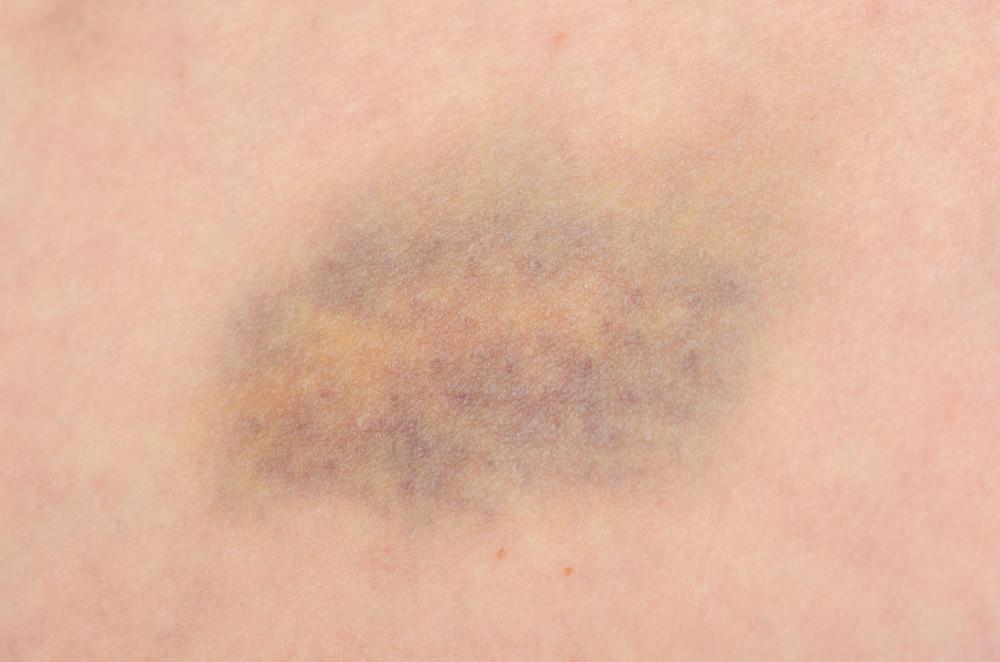At WiseGEEK, we're committed to delivering accurate, trustworthy information. Our expert-authored content is rigorously fact-checked and sourced from credible authorities. Discover how we uphold the highest standards in providing you with reliable knowledge.
What are the Most Common Hamstring Injury Symptoms?
The hamstring is the tendon that attaches a sizable group of muscles on the backside of the thigh to the bone. This group of muscles — the hamstring muscles — are commonly referred to as the hamstring, so most hamstring injuries are actually injuries of the muscle group instead of the actual hamstring tendon. Hamstring injuries range from minor to severe, from a strain to a full muscle tear, and there are several hamstring injury symptoms that alert the sufferer to an injury. Most hamstring injury symptoms involve sudden pain or a tearing sensation in the hamstring muscle region; swelling or bruising may also appear after the injury has occurred.
Hamstring injuries often occur while playing sports, especially those that involve sprinting intermingled with quick stops and starts, and jumping or lunging, such as basketball, soccer, and American football. Many hamstring injuries are immediately noticeable and are often prompted by a sudden jerk, which leads to their general identification of a pulled hamstring. Hamstring injury symptoms may include a sharp pain in the hamstring muscle region that emerges suddenly while playing a sport, a tearing sensation in the hamstring muscles, or a popping or snapping sound. Often, an athlete that pulls his or her hamstring will be unable to continue the activity and, in some cases, may be unable to stand.

Since pain is generally felt immediately in the hamstring region, an athlete will almost always be aware that an injury has occurred. A strained or pulled hamstring is ordinarily accompanied by tenderness in the hamstring region and possible swelling. In the case of more severe injuries, such as a torn hamstring, the back of the thigh may appear bruised and a region of the skin may turn black and blue. Sometimes the injury to the muscle can be felt as an imperfection and is detectable by touching the skin.

The majority of hamstring injuries are curable without surgery, though in serious conditions, such as a full muscle tear, surgery may be required. Minor hamstring injuries are treatable at home without consulting a doctor. In these cases, doctors recommend resting and icing the affected region along with compression and elevation — these four combined forms of treatment are collectively referred to as RICE. Hamstring injury symptoms that call for doctor assistance include redness spreading from the injured area, any numbness in the region, and an inability to bear any weight on the affected leg. Recurring hamstring injuries should also be examined by a doctor.
AS FEATURED ON:
AS FEATURED ON:

















Discussion Comments
I pulled a hamstring performing lunges with too much weight about five years ago. I healed after a few weeks, but I have since become a long-distance runner and I have noticed that I occasionally (once a year or so) get some pain at the injury site when I have been over-reaching in my training, especially running hills. This puzzled me because hamstrings are not usually a problem for endurance runners, but then I remembered my previous injury from weight training.
My plan now is to work at strengthening the hamstring by carefully performing lunges with not much weight. As the muscle becomes stronger, I imagine that there will be less and less likelihood of it being an issues with my running.
I know immediately when I have pulled a hamstring. That is a pain that you feel right away, and stays with you for a long time afterward.
I think a hamstring strain is so annoying because you can't move much without being reminded of the injury.
This usually happens to me when I have not stretched before I start working out. You would think I would have learned my lesson by now, but still find myself trying to take that short cut every now and then.
Post your comments